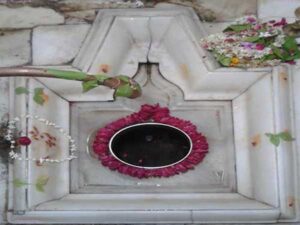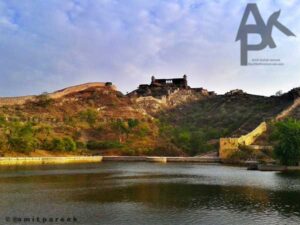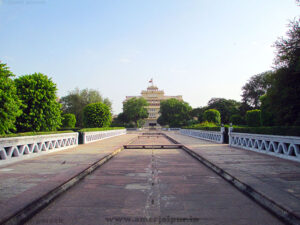“Jantar Mantar” these two magical and mysteries words chanting in India by many people in their childhood to fulfill their magical dreams but these words are more than that. The term “Jantar Mantar” literally means “instruments for measuring the harmony of the heavens”. In Jaipur city there are palaces, temples, gardens and ponds they all have their importance in their place but the astronomical observatory established by the king Sawai Jai Singh have International importance. The Jantar Mantar houses various architectural and astrological instruments that have caught the interests of astronomers, historians and architects around the world. It is considered to be one of the largest observatories ever built.
Who built Jantar Mantar?
In the early 18th century Maharaja Sawai Jai Singh II of Jaipur constructed five Jantar Mantar in total in New Delhi, Jaipur, Ujjain, Mathura and Varanasi. They were completed between 1724 -1735. The Jantar Mantar observatory was constructed between 1728 -1734. It is the largest observatories among five and best preserved and still running. It is a collection of 19 architectural astronomical instruments. It features the world’s biggest stone sundial “Smarat Yantra”, and is UNESCO World heritage site. The one observatory in Mathura has almost disappeared today.
Why was Jantar Mantar built? Jantar Mantar history.
This observatory was built in 1734 for the study of space and time. The builder of the Jantar Mantar Maharaja Sawai Jai Singh was a brilliant star and great scholar of his subjects like astronomy and Indian politics. He is the ruler of Amber and founder of Jaipur, a great builder and ruler and exceptional astronomer. Sawai Jai Singh II was commissioned by Emperor Muhammad Shah, to make corrections in the astronomical tables and to confirm the data, already available on the planetary positions.
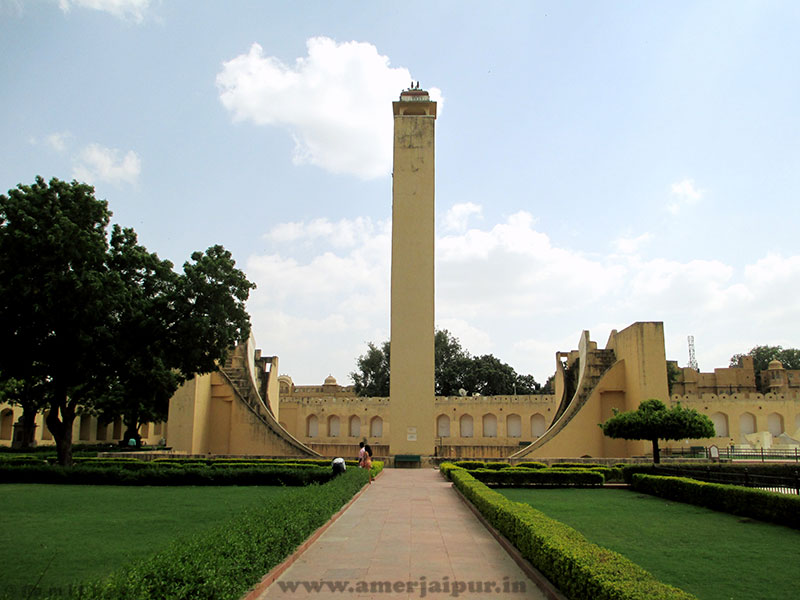
Jaipur sundial at Jantar mantar (Vrihat Smarat Yantra)2 amerjaipur.in
The main aims of Jai Singh II scientific program were to refine the ancient Islamic zij tables, to measure the exact hour at continuously and to define the calendar precisely. Another aim was to apply the cosmological vision deriving from the Ptolemaic one based upon astronomical facts to astrological prediction both social and individual. Sawai Jai Singh is aware of Hindu tradition of astronomical data and he also studies all the astronomy related books and data of Europeans, Islamic and Persian civilization and collects all the data and adopts the data. That helps him for building observatory. For collecting data Sawai Jai Singh II sent his envoys to various parts of world. The emissaries came back with manuals and astronomical tables besides tones of data on the advances made in the fields of astronomy. La Hires’s tables was one of these manuals. The Jantar mantar is also called the renewal edition of the observatory of the king Ulugh Beg ruler of Samarkand 1339-1449 at Uzbekistan. But it was more accurate compare to Ulugh Beg observatory. Where Ulugh beg observatory is called as “mistake of its time”. The first prime minister of India Pundit Jawaharlal Nehru wrote “not a mistake of its time”.
It took seven years to finish the task. He built the first stone observatory in 1724 in Delhi. The Jaipur observatory of Rajasthan was built in 1728-1734. The king Sawai Jai Singh built three more observatories in various places. The Jaipur observatory is the largest and more accurate than others.
Jantar mantar is the most complete and best preserved great observatory site built in the Ptolemaic tradition. It provides an outstanding testimony of the scientific and technical conceptions of the great observatory devised in the medieval world.
Jantar Mantar Observatory
Jantar mantar is located near City Palace and Hawa Mahal of Jaipur. The observatory is collection of 19 geometric devices for measuring time and space for astronomy. It is also used for observing the orbits around the Sun. While the previous observatory like King Ulugh Beg was build from metal but it was less accurate and not use for long period. So Sawai Jai Singh II decided to build the observatory instruments with stone and marble because stone life is longer than metal and does not wear and tear easily. The instruments allow the visitors to observe the astronomical positions with the naked eye. Some of the instruments are built from bronze.
Jantar Mantar is situated in 18,700 square meters of area. The observatory restored several times during these years particularly in 1902 in British rule and also in 2006 and replaced some of the original materials of construction with different materials. It is still in use today, both for teaching and calculation purposes and retains extra-ordinary accuracy. Some of the instruments uses are still mystery for visitors and how we can use them and how accurate predication they gave in time of 18th century. And some of the instruments are largest in world. Now it is part of a National monument of Rajasthan and also a part of UNASCO world heritage site. Some of the instruments used in the observatory of Jantar mantar Jaipur Rajasthan India are mentioned below.
Jaipur sundial at Jantar mantar (Vrihat Smarat Yantra)
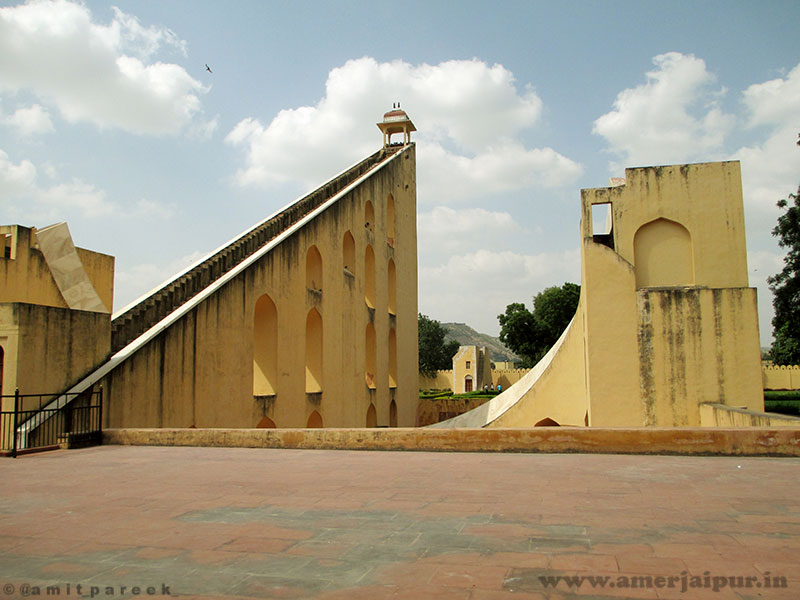
The Vrihat Samrat yantra is a sundial that can give the local time to an accuracy of 2 seconds. Restored A.D. 1901 tested by jotshi Gokul chand bhawan for finding time and declination and hour angle of the heavenly bodies. It is the largest sundial ever built with a gnomon arm 22.6 meter high and largest quadrants of radius 15.5 meter. The shadow of the triangular wall, which is placed in the north-south direction with an angle equal to the latitude of this location moves equal distances in equal time intervals, on the eastern and western side quadrants. This movement is calibrated to read the local time. The western and eastern quadrants are divided into 6 hours each, for the morning and the afternoon segments respectively. Each hour is divided in 15 minutes and later in 1 minute parts. The minute part has ten subdivisions each of 6 seconds each of which again has three small divisions of 2 seconds each. The correction factor which is to be added for the day is displayed to convert the time obtained from this instrument to the clock time.
Small samrat yantra
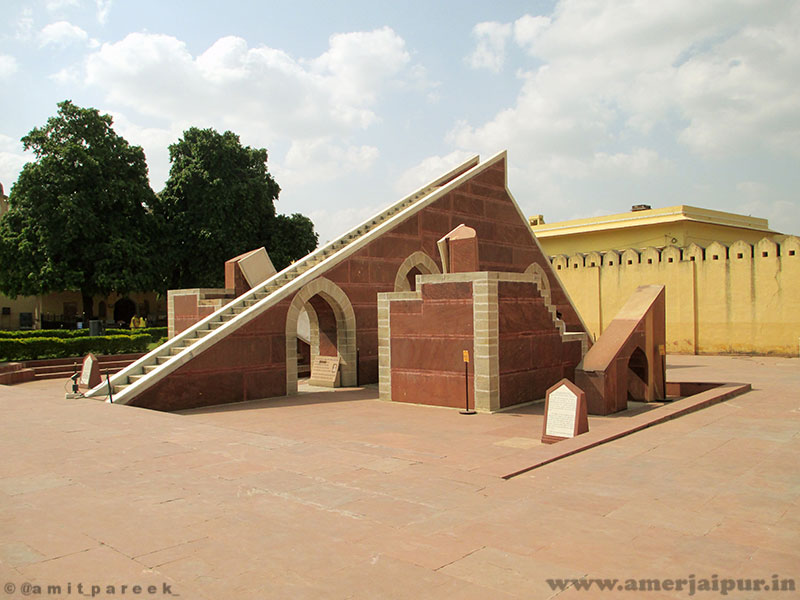
Small samrat yantra amerjaipur
The small samrat yantra is a sundial that can give the time to an accuracy of 20 seconds. The shadow of the triangular wall of the yantra, falling on the eastern & western side quadrants, tells the local time. The triangular wall, with the angle inside the wall is place exactly in the north-south direction. The shadow of the triangular wall moves equal distances in equal time intervals on the quadrants. This movement is calibrated to read the local time. The western & eastern quadrants are divided into subdivisions, each of 6 hours, for the morning and the afternoon segments respectively. Each hour is further divided into 5 minutes and 1 minute divisions, and each 1 minute division is subdivided into 3 divisions each of 20 seconds. The correction factor, to be added to convert the sundial time to the clock time for the day is displayed near the instrument.
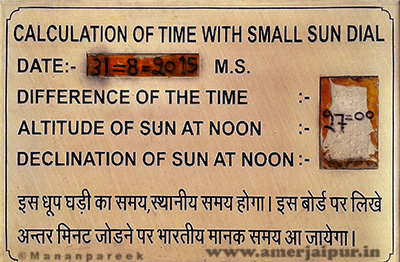
Unnatamsa
Unnatamsa is an instrument for measuring altitude the angular height of an object in the sky.
Rasivalaya (zodiacal circle)
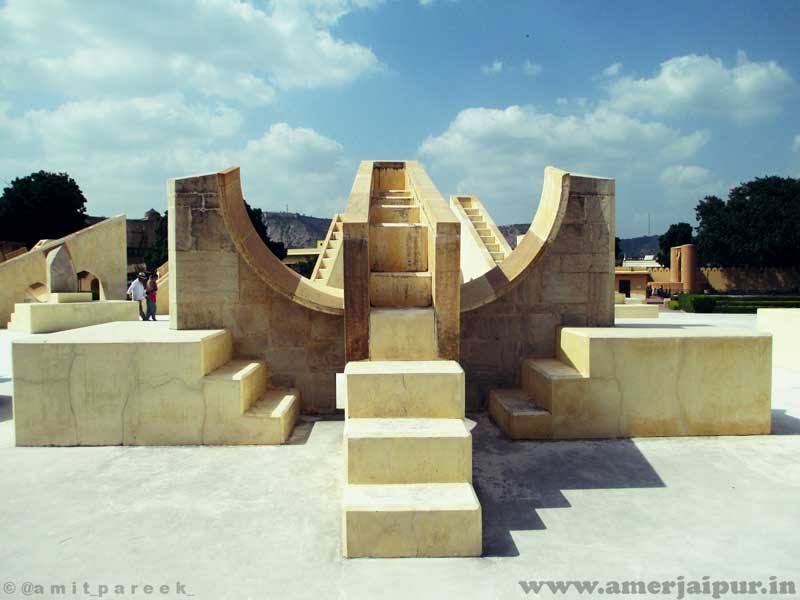
Rasivalaya are instruments for measuring the celestial latitude and longitude of the celestial bodies. There are twelve instruments which represent the twelve signs of the zodiac, one for each measurement to be done when the corresponding sign of the zodiac transits the meridian.
Jaya prakash yantra
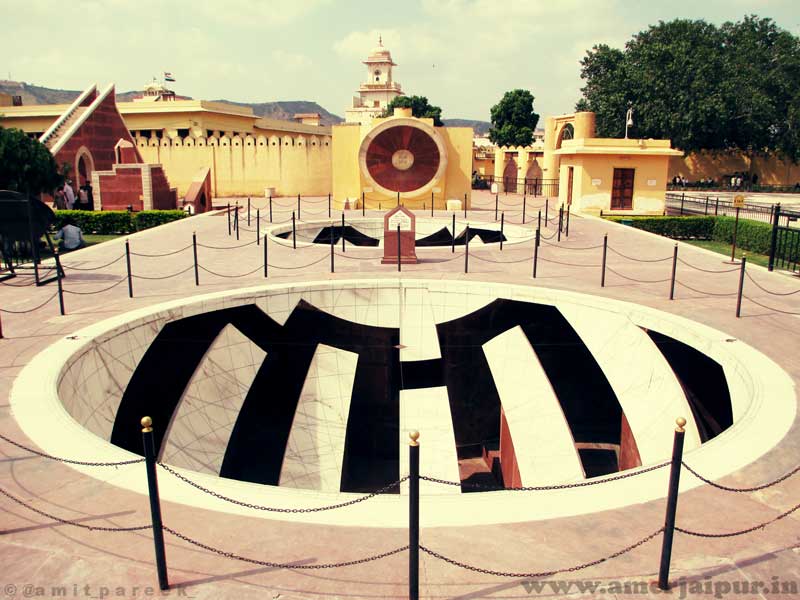
Repaired A.D. 1901 representation of half celestial sphere rim represents horizon for finding all the positions of the heavenly bodies.
Nadivalaya (equatorial instrument / circular dial)
The nadivalaya has two circular plates, facing north and south which are its dials. The wall of the plates is inclined towards the south at such an angle that the instrument remains parallel to the plane of the Earths equator.
Chakra yantra
The chakra yantra is a ring instrument which measures the global co-ordinates of declination and the hour angle of a celestial object.
Digamsa (Azimuth)
The digamsa is a cylindrical instrument that has a simple method of determining the azimuth of a celestial object. Digamsa or the azimuth of a celestial object is the relative angular position of the object measured east words starting from the direction north.
Ram Yantra
The Ram Yantra can measure the local co-ordinates of altitude and azimuth of a celestial object.
Rama yantra A
Repaire A.D. 1891 tested by jotshi Gokul chand bhawan. This gives the altitude and azimuth of the sun and of the heavenly bodies.
Karnti writta
The use of this instrument is to find the declination and distance from the ecliptic and equinox of the sun and stars.
Krantivrtta
The krantivrtta is an instrument that is meant to measure the celestial latitude and celestial longitude of an object in the sky. It is also used for measuring solar sign of the sun in daytime.
Yantra Raj
The yantra raj is an adaptation of an astrolabe a medieval instrument for the measurement of time and the positions of celestial objects.

